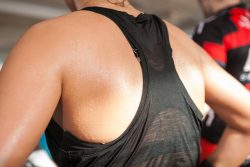 Skin, the body’s largest organ, acts as a protective barrier against various environmental threats. However, as it ages, it becomes thinner and more prone to damage. While exercise is widely known for its health benefits, its impact on skin aging has been largely ignored.
Skin, the body’s largest organ, acts as a protective barrier against various environmental threats. However, as it ages, it becomes thinner and more prone to damage. While exercise is widely known for its health benefits, its impact on skin aging has been largely ignored.
A recent study in Nature Scientific Reports revealed that both aerobic and resistance training can improve certain aspects of skin aging. Interestingly, only resistance training was found to increase skin thickness, which is a crucial factor in maintaining youthful skin. These findings highlight the importance of incorporating resistance exercises into our fitness routines for healthier and more resilient skin.
In this groundbreaking study, researchers conducted a 16-week study on 61 sedentary middle-aged women in Japan. The participants were randomly assigned to two groups: one focused on aerobic training and the other on resistance training. Before and after the program began blood samples were taken.
The results of the study showed that aerobic training led to a significant decrease in body weight and body mass index, as well as an improvement in aerobic capacity. On the other hand, resistance training increased lean mass and muscle strength. In terms of skin aging, both types of training had a positive impact. They improved skin elasticity and the upper dermal structure. However, only resistance training resulted in an increase in dermal thickness.
To understand how the interventions improved skin aging, the effects of aerobic training and resistance training on the expression of genes were analyzed in relation to the extracellular matrix (ECM) in human dermal fibroblasts. The plasma blood samples that were taken before and after the program were then added to the cultured fibroblasts. The results were striking! Both types of training showed improvements in the expression of ECM-related genes, including those involved in collagen production.
However, there were some differences between the two. Aerobic training had a greater impact on collagen-related genes, while resistance training specifically affected the gene responsible for biglycan, a crucial protein that maintains tissue structure by interacting with collagen fibers in the ECM. Out of all the proteins affected solely by this type of exercise, biglycan stood out as a key player. Exercise doesn’t just transform our physique, but it also influences the expression of genes in our skin cells through circulating factors.
With 1480 factors under scrutiny, researchers honed in on three specific ones that showed a negative correlation with the increase in biglycan levels after resistance training. Interestingly, all three of these factors are known to be pro-inflammatory. Nevertheless, the experts acknowledge the need for animal studies to definitively confirm the mechanism behind resistance training’s ability to rejuvenate the skin.
These findings highlight the significance of both aerobic and resistance training in promoting healthy skin aging by enhancing the integrity of the extracellular matrix.
To view the original scientific study click below:
Resistance training rejuvenates aging skin by reducing circulating inflammatory factors and enhancing dermal extracellular matrices





